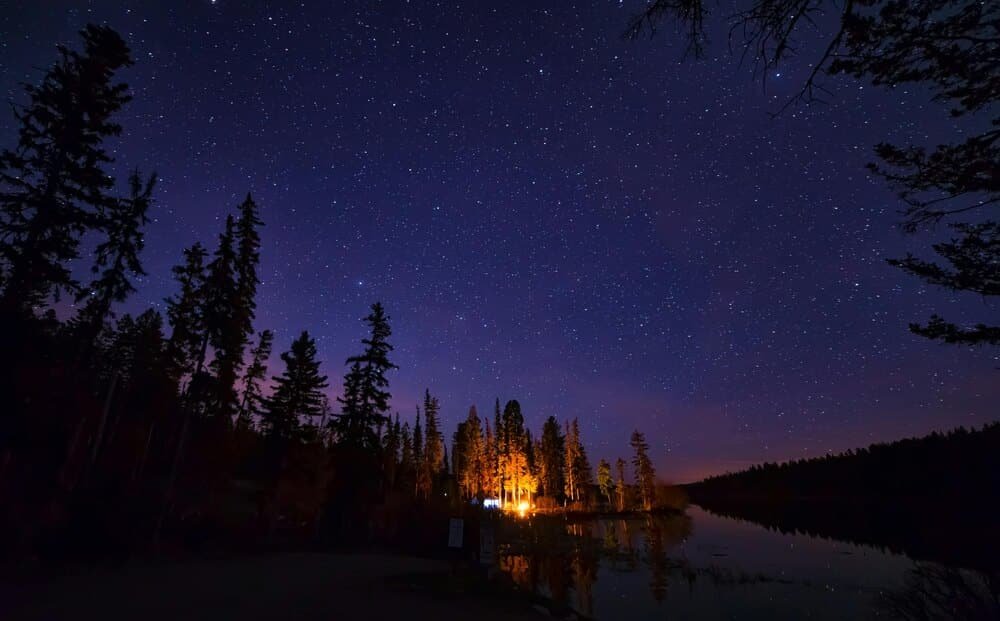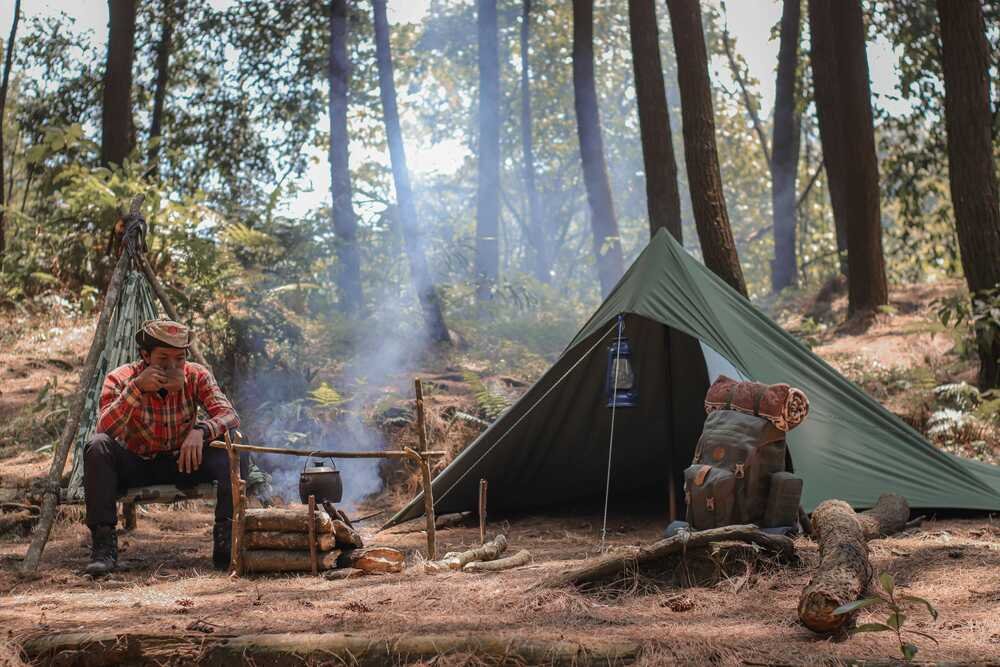You are miles away from any campground with only the stars in the sky for company. You are surrounded by the gentle sounds of nature. This is the incredible reality of dispersed camping in California.
Beginners can engage in dispersed camping in California’s National Forests. The sheer amount of public land and diverse terrain offer incredible opportunities for novice campers to experience the wilderness. Beginners should be well prepared and prioritize locations with well-established trails and easily available information on fire restrictions and safety.
Dispersed camping is when you leave a developed campground to find a secluded spot. The vast beauty of California’s National Forest is the perfect place to experience the outdoors. This is camping on your own terms, a marvelous experience when you are new to outdoor adventure.
Why go dispersed camping in California’s National Forest?
If you dream of starry nights and birds chirping in the morning, but want to be away from a busy campground, dispersed camping in California’s National Forest could be the answer. Away from the crowded campsite and strict rules, you’ll experience a more personalized adventure. Imagine exploring a pace that suits you, finding and choosing your own secluded spot amidst mountains, deserts, or coastal forests.
Some of the benefits of being in nature:
Table 1. nature benefits
| No. | health/Well-being Benefits | References |
| 1 | Reduced stress | Berto 2014 |
| 2 | Better sleep | Astell-Burt et al. 2013 |
| 3 | Improved mental health: | |
| Reduced depression | Beyer et al. 2014 | |
| Reduced anxiety | Bratman et al. 2015a | |
| 4 | Greater happiness, well-being, life satisfaction | Ambrey 2016 |
| 5 | Reduced aggression | Bogar and Beyor 2016 |
| 6 | Reduced ADHD symptoms | Amoly et al. 2014 |
| 7 | Increased prosocial behavior and social connectedness | Dadvand et al. 2016 |
| 8 | Lower blood pressure | Duncan et al. 2014 |
Benefits vs. Developed Camping:
- Freedom: You don’t have to make a reservation, just hit the road when you feel inspired. California’s National Forest is vast, so you can set up almost anywhere (within regulations, of course!).
- Simplicity: Don’t be intimidated by the idea of dispersed camping! If you can pitch a tent in your backyard, you have the skills to find a campsite in a National Forest.
- Unmatched Scenery: Leave your RV or SUV behind and discover your own slice of California, whether nestled among redwoods or overlooking a desert sunset.
Dispersed Camping in California: Easy Planning Tips for Beginners
Journeying into the wildness for a dispersed camping adventure is a rewarding experience. Also, it’s much easier to get started than you think! I want to dive into the basics to give you the knowledge and confidence needed for a successful trip.
Research and Regulations: It’s Not so Complicated
Your first priority is knowing where you can camp. You’ll have plenty of choice when it comes to California. Fortunately, most of the information is online.
- Check out the Forest Service: A vast collection of dispersed camping spots can be found on National Forest land. California has a total of 20 National Forests, and many are available to camp in the wild.
- Need-to-Know for Beginners: Focus on fire restrictions (are campfires allowed?) You no doubt watch the news, fires are a major concern in California. Also, check what permits may be needed, and keep up-to-date on any area closures.
Gear Checklist: Less than you think!
Don’t think you need to buy a whole new set of equipment. Here’s a list of dispersed camping essentials, with the beginner in mind:
- Tent: A basic dome shaped tent is perfect; make it your priority to keep the rain out.
- Sleeping bag: No need for subzero ratings! A normal warm-weather bag is a great starter.
- Sleeping pad: Don’t skip this one! A pad will add comfort and insulation from the ground.
- Camp chair: Optional, but great for relaxing.
- Headlamp: Essential when you need to find something at night.
- Food and Cooking gear: Keep meals simple. (bring some pre-made options)
- Water and purification: Water storage and water filter/purification options.
Leave No Trace Principles: Be a Responsible Nature Explorer
Camping in wonderful places comes with the job of protecting them. I’ve mentioned Leave No Trace many times, but it’s always worth repeating. Always try to do the following:
- Pack it in, pack it out: Whatever you bring, take it back with you.
- Camp on durable surfaces: Located on rock or bare soil.
- Be fire-smart: Only build fires when allowed, and completely put them out when finished!
- Respect wildlife: Keep your distance, and store food properly.
Navigation: Simple is best for Newbies
For your first dispersed camping trip, a good map is usually enough to find your way.
- Pick up a forest map: Available at the Ranger Station or online.
- Learn basic map reading: It’s a valuable skill. You can find free or inexpensive courses online that will teach you this invaluable skill.
Remember, if you’ve done any kind of basic camping you are ready for dispersed camping. When planning, start small, focus on the essentials, and get ready for an amazing adventure.

Setting up Camp
You did it! You’ve arrived at a gorgeous spot in the wilderness, now it’s time to set-up your temporary home. Here’s how to set up like a pro, even on your first trip.
Site Selection: Safety and Comfort First
- Seek out flat ground: You don’t want to spend the night rolling into your tent-mate!
- Check up and around: Avoid setting up under dead tree branches or near loose rocks.
- Respect established sites: You may find an existing fire ring, minimizing your impact will be easy – camp there!
Leave No Trace Camp Setup
- Durable surfaces are your friend: Camp on bare ground, rocks, or existing campsites.
- It came with you, it leaves with you: Every snack wrapper, every tissue, everything – pack it all out.
Fire Safety 101
- Know the rules: This is California, forget about building a fire. But if you insist, check with the Ranger stations or the Forest Service website. They will tell you if/where fires are allowed.
- Build small: Start with twigs and kindling. A big bonfire will be a recipe for disaster.
- Your fire’s home: Use an existing fire ring, or bring a portable fire pit that’s off the ground.
- Never leave it alone: One gust of wind could cause a major problem. Douse your fire completely with water before sleeping or leaving.
Water = Life (especially clean water)
- Purification tablets are your friend: It is considered the easiest method for beginners. Just follow the directions on the bottle! There are many other options, on future trips you may want to look at water filters.
The bathroom
Please read my article, it’ll tell you everything you need to do: WHAT’S THE BEST WAY TO DISPOSE OF HUMAN WASTE WHILE ENJOYING DISPERSED CAMPING?
Campfire Cuisine (keep it simple!)
- Embrace freeze-dried meals: Just add boiling water – most come in their own self contained pouch for easy cleanup.
- Or try this: “Cowboy Ramen” – boil water, add ramen noodles, and a spoonful of peanut butter at the end. Sounds strange, tastes pretty good! The easiest meal you’ll ever make.
Wildlife Wonders
- Your food = their temptation: Seal food tightly in a container.
- A little noise is good: Bears will avoid you! Talk or clap occasionally while hiking.
- Remember: Seeing wildlife is a great gift, but watch safely from a distance.
I talk more about this in my article: HOW DO YOU STAY SAFE AROUND LOCAL WILDLIFE WHEN CAMPING?
Conclusion: The Wilderness is waiting for you!
Dispersed camping will give you a unique sense of freedom and connection to nature, quite a contrast to a crowded campground. And guess what? It’s absolutely achievable, even on your first try! Start small, embrace the learning curve, and you’ll be rewarded with an adventure that will live with you forever.
Ready to Take the First step?
To start, explore the National Forests website. Consider downloading the app too. With a bit of searching you should be able to find dispersed sites. Also, you’ll learn about regulations and extra tips for first-timers. Don’t let fear hold you back!
FAQ: Busting Common Worries
“What if I get lost?” A good map and a basic understanding of how to use it go a long way. (Plus, there are handy smartphone apps for that!)
“Isn’t it dangerous?” With awareness and preparation (proper food storage, respecting wildlife), the risks are minimal. Dispersed camping can be incredibly safe!
“What about bad weather?” Checking the forecast and packing accordingly (rain gear, layers) are key. If severe weather hits, prioritize safety and head home.
“What if I need the toilet?” Remember those Leave No Trace principles! Locate a suitable spot far from water sources, and bury waste (and toilet paper) in a small hole.
“Won’t I be lonely?” Dispersed camping can be a wonderful solo adventure, or a great way to bond with friends and family! The choice is yours.
The journey starts here – go explore!
Further Reading and Resources
- The Authority on Dispersed Camping: The US Forest Service website is your go-to source for rules, regulations, and finding suitable areas on National Forest land. [https://www.fs.usda.gov/visit/know-before-you-go/camping]
- Learn the Ropes: REI, the outdoors store, offers great articles and tutorials covering everything from gear basics to essential camping skills. [https://www.rei.com/learn/expert-advice]
- Leave No Trace Center for Outdoor Ethics: Mastering these principles ensures you can enjoy the wilderness responsibly. [https://lnt.org/]
References
Berto R. 2014. The role of nature in coping with psycho-physiological stress: A literature review on restorativeness. Behav Sci (Basel) 4(4):394–409. https://doi.org/10.3390/bs4040394.
Astell-Burt T, Feng X, Kolt GS. 2013. Does access to neighborhood green space promote a healthy duration of sleep? Novel findings from a cross-sectional study of 259 319 Australians. BMJ Open 3(8):e003094. https://doi.org/10.1136/bmjopen-2013-003094.
Beyer KMM, Kaltenbach A, Szabo A, Bogar S, Nieto FJ, Malecki KM. 2014. Exposure to neighborhood green space and mental health: Evidence from the survey of the health of Wisconsin. Int J Environ Res Public Health 11(3):3453–3472. https://doi.org/10.3390/ijerph110303453.
Bratman GN, Hamilton JP, Daily GC. 2012. The impacts of nature experience on human cognitive function and mental health. Ann N Y Acad Sci 1249:118–136. https://pubmed.ncbi.nlm.nih.gov/22320203/. https://doi.org/10.1111/j.1749-6632.2011.06400.x.
Ambrey CL, Cartlidge N. 2017. Do the psychological benefits of greenspace depend on one’s personality?. Pers Individ Dif 116:233–239. https://doi.org/10.1016/j.paid.2017.05.001.
Bogar S, Beyer KM. 2016. Green space, violence, and crime. Trauma Violence Abuse 17(2):160–171. https://pubmed.ncbi.nlm.nih.gov/25824659/. https://doi.org/10.1177/1524838015576412.
Amoly E, Dadvand P, Forns J, Lopez-Vicente M, Basagana X, Julvez J, et al. 2014. Green and blue spaces and behavioral development in Barcelona schoolchildren: The BREATHE project. Environ Health Perspect 122(12):1351–1358. https://pubmed.ncbi.nlm.nih.gov/25204008/. https://doi.org/10.1289/ehp.1408215.
Dadvand P, Bartoll X, Basagaña X, Dalmau-Bueno A, Martinez D, Ambros A, et al. 2016. Green spaces and general health: roles of mental health status, social support, and physical activity. Environ Int 91:161–167. https://pubmed.ncbi.nlm.nih.gov/26949869/. https://doi.org/10.1016/j.envint.2016.02.029.
Duncan M, Clarke N, Birch S, Tallis J, Hankey J, Bryant E, et al. 2014. The effect of green exercise on blood pressure, heart rate and mood state in primary school children. Int J Environ Res Public Health 11(4):3678–3688. https://doi.org/10.3390/ijerph110403678.


Pingback: Campground Etiquette: How to Be the Best Campsite Neighbor - novus places
Pingback: Is camping a good experience? - novus places